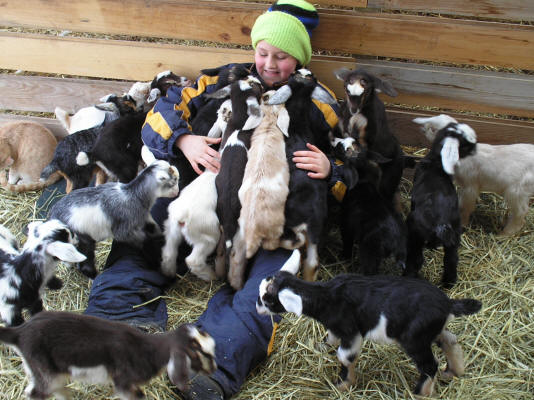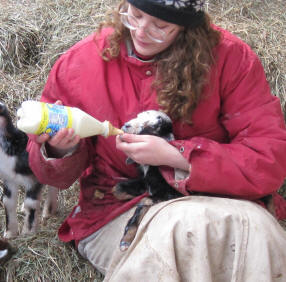How to Bottle Feed Goat Kids
How do you feed a baby goat? A very common question and of course there are about as many different answers as there are goat breeders. Below is how we feed our MiniNubian kids. This program is for kids that will mature at about 100 lbs. You will want to increase the amounts for larger breeds and decrease it for smaller breeds.
Here is what we do with our MiniNubian kids.
At birth, they get as much warm colostrum as they want.
For the first few days up to a week, we feed them about every 4
hours letting them have all the milk they want up to 4 cups a day. We feed at 6am, 10am, 2pm, 6pm, 10pm, 2am when doing these
early feedings. That way we can all get a fairly decent amount of sleep
- one person stays up late to feed, one person feeds in the middle of
the night and one gets up early.

After about a week we start feeding them 3 times a day, as soon as we get up in the morning, in the middle of the day and right before we go to bed (usually 6am, 2pm and 8pm). They are still getting up to 4 cups a day. By this time, they usually think they want more than that, but they are really more thirsty than anything else – so we make sure to have warm water available in a bucket for them to drink. They are moved onto the Lam-Bar as soon as they are off colostrum and are drinking well enough to suck the milk up the straw. For some kids this is as early as 4 days old while others take a week or two to get the hang of it.
After a month we cut them back to two feedings a day – 2 cups in the morning, 2 at night. At, or a little after, 3 months old, they are eating hay and drinking water very well and we start to wean. We do this by cutting back the amount of milk until they are down to pretty much nothing and then stop. All our kids have fresh hay, water and minerals available free choice from a few days old. Some people may think that a quart a day of milk is not enough for the kids, but I have found that if you give them as much milk as they want they will over eat and get scours. Also restricting the amount of milk causes them start eating hay at an earlier age which helps develop the rumen resulting in more capacity as an adult so they can produce more milk.
As for when you start getting milk for your own use, that really depends on your does milk production and how many kids you have. We usually have extra milk for a while after the kids are born and then again when we are getting closer to weaning.
It took me a few years to develop this program for feeding the kids, but I have been using it for many years and have had great results.
How to Feed the Kid, Step-By-Step:
You will need:
- A source of milk - whole, raw goats milk from a clean herd (CAE, Johnes, CL etc. free) is best, but whole cows milk can be substitute. If you are not sure on the disease status of the goats milk you are using, it should be pasteurized to prevent the spread of CAE, Johnes, etc.
- A bottle (water bottles/pop bottles work great)
- A nipple (we just use lambar nipples on pop bottles until they are drinking well enough to get it out of the lambar feeder)
- A pot
- Measuring cup
- A hungry kid!
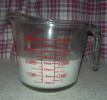 |
Measure out the amount of milk you will need for this feeding. For MiniNubian kids, we feed one quart per day per kid. So once you are doing 2 feedings a day, that is 2 cups per kid per feeding. |
 |
Heat the milk in a pot on the stove. Do NOT use a microwave. It may be more convenient, but it destroys the health properties of the milk. This is especially important with colostrum. Watch it so it doesn't scald (for colostrum, keep your fingers in it the whole time you are heating it as it scalds REALLY easily). You want the milk at about 104 degrees (a goats body temperature) or a little warmer. It should feel comfortably warm - about the temperature you would want bath water; not chilly, but not scalding hot either. If it is cold outside, heat it a little warmer as it will cool while you are outside. Use a funnel to pour the milk into the bottle (or just pour into the lambar if feeding multiple kids). |
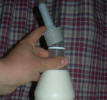 |
Put the nipple on the bottle. We use nipples from the lam-bar feeder as we put all kids onto the lambar once they are sucking strong enough to bring it up the tubes. |
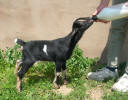 |
For older kids who already understand how to nurse, all you need to do is offer them the bottle and they will latch on and empty the bottle quickly! Newborns or kids who are being moved from mom to the bottle may need a bit more training. (See tips section for help with getting newborns to drink) |
|
|
After feeding, bring the bottles and nipples (or lambar equipment) in and rinse with cold water immediately. Then wash with warm soapy water. If using the lambar, wash the tubes with the tube brush once a week (or more often if needed). |
A few tools to make feeding many kids easier:
|
The Multi-Kid feeder sold by Hoeggers feeds up to 6 kids at a time. |
|
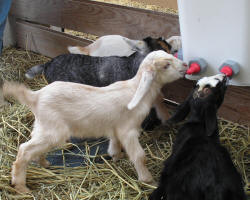 |
Pros:
Cons:
|
The Lam-Bar Feeder is sold by Hoegger's, Jeffers and Caprine Supply and is my favorite multiple kid feeder |
|
  |
Pros:
Cons:
|
If your newborn kid doesn't want to take the bottle, a good trick is to imitate how a doe treats the kid. Rubbing the top of their head triggers the rooting instinct and they will look for milk. The doe usually licks the kid under and around the tail area which seems to stimulate them to look for milk. So... you can hold the kid on your lap with the bottle in one hand. Lower your head down to the kid where their head is just under your chin. Hold the bottle near your chin and rub their head with your chin. At the same time, tickle their back end with your free hand. This is MUCH easier if you have two people and you can hold the kid and bottle with one hand while someone else tickles their rear. You can also use your free hand to guide their mouth to the nipple although some kids will fight that.
When feeding newborns, wear clothes that you don't mind getting dirty as you will likely end up covered in colostrum!
Resources
Hoegger's Goat Supply (Nipples and Lam-bar Supplies)
Caprine Supply (Nipples and Lam-bar Supplies)

